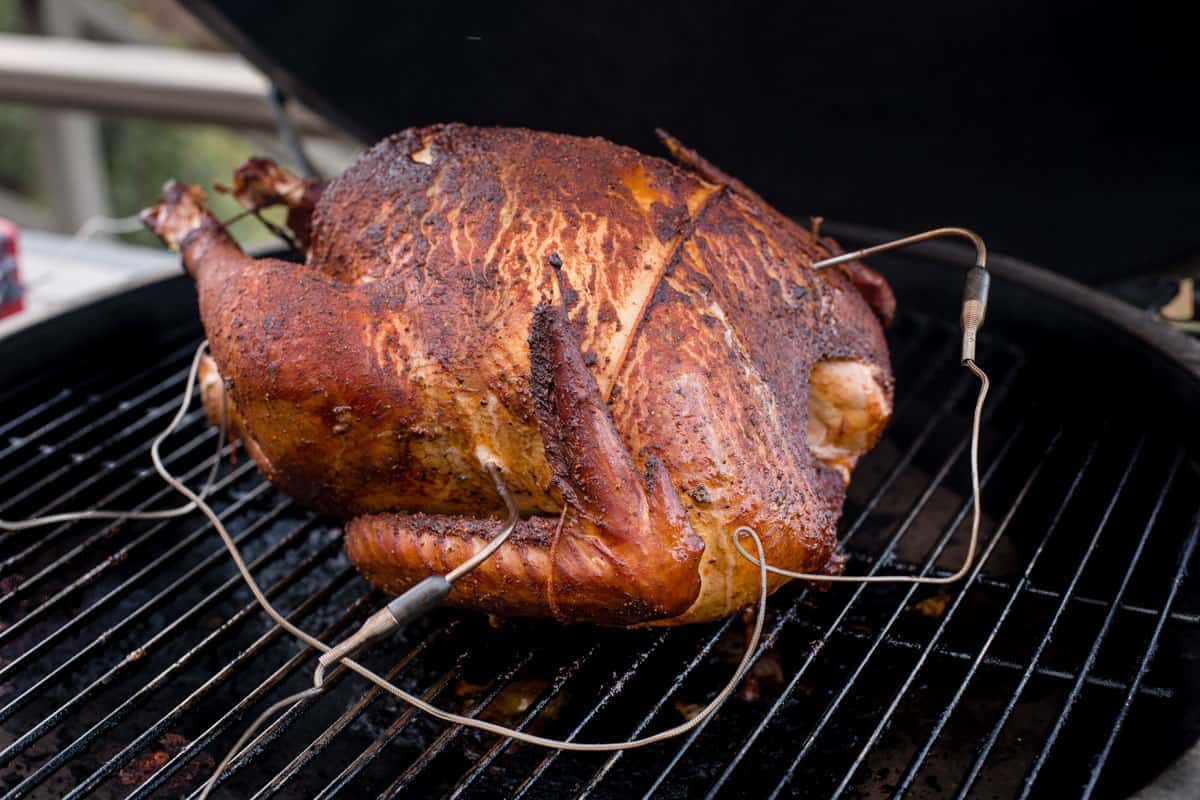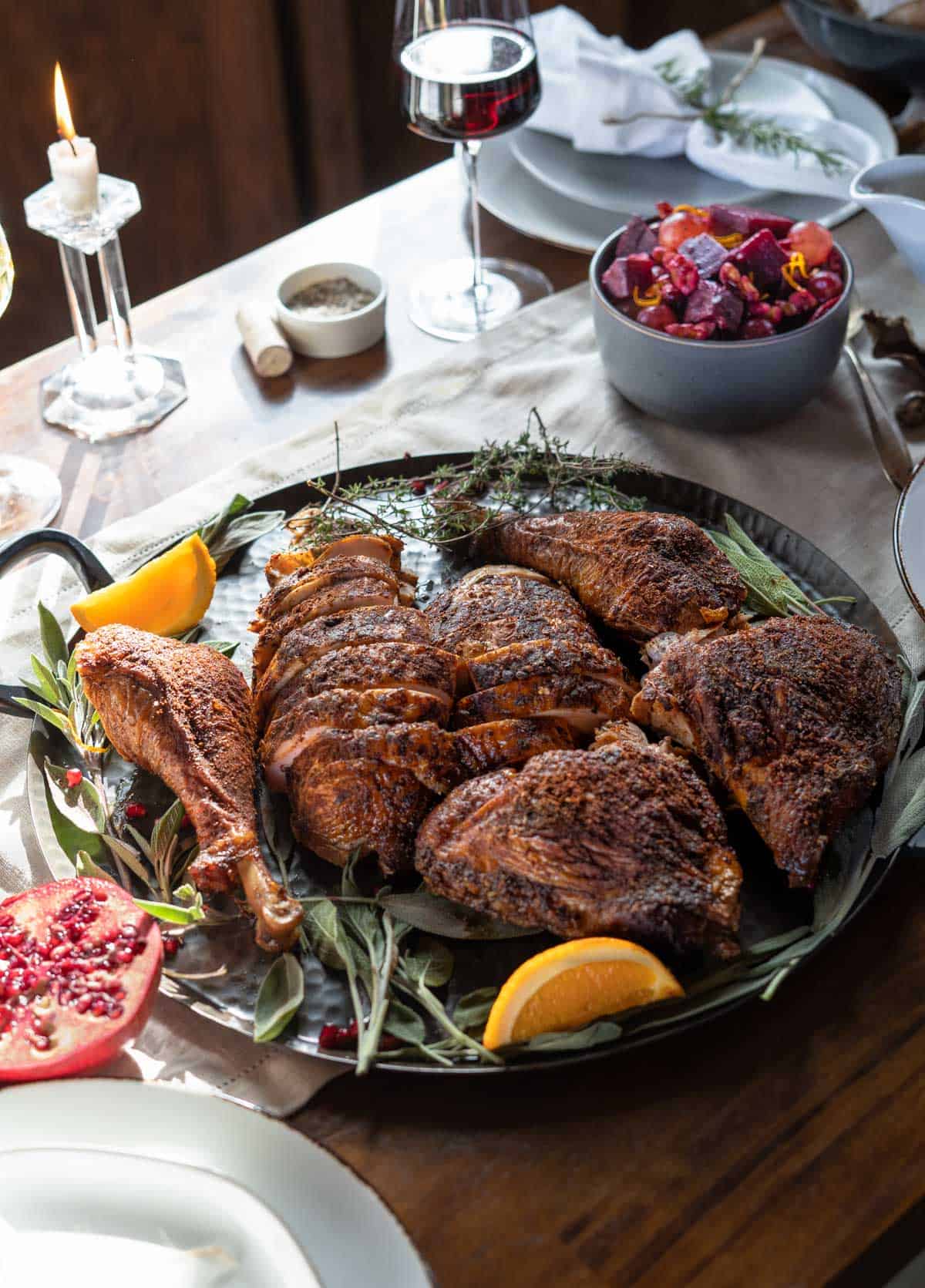From a bourbon citrus brine to herbed butter tucked under the skin to the best turkey seasoning, this smoked turkey is bursting with flavor. Your Thanksgiving turkey is going to be the star this year. This is the greatest smoked turkey recipe there is, with hundreds of happy customers, and one that will leave your guests asking for seconds.
Looking for another creative way to smoke your turkey? Check out our recipe for Cajun Spatchcocked Smoked Turkey.
Ah, Thanksgiving. A time for family, friends, and of course, the iconic turkey. But for many the thought of turkey conjures up less-than-appetizing images: dry, bland, and, dare we say, napkin-like. But is this perception justified? Or is it time to debunk the “turkey tastes like napkins” myth once and for all?
Why Does Turkey Get Such a Bad Rap?
There’s no denying that turkey can sometimes fall short of culinary expectations. However, the reasons behind its lackluster reputation are often rooted in a combination of factors:
Cooking Mishaps: Overcooking is the arch-nemesis of juicy, flavorful turkey. High temperatures and prolonged cooking times can leave the meat dry and tough, creating that infamous napkin-like texture.
Lack of Seasoning: A bland bird is bound to be a bore. Proper seasoning with salt, pepper, herbs, and spices is key to unlocking the true flavor potential of turkey.
Bird Selection: Not all turkeys are created equal. Choosing a high-quality, fresh turkey from a reputable source can significantly impact the taste and texture.
Psychological Bias: Let’s face it, the “turkey tastes like napkins” narrative has become ingrained in our cultural consciousness. This preconceived notion can influence our perception, making us more likely to focus on the negative aspects of the experience.
Unmasking the Real Flavor of Turkey: Tips for a Delicious Bird
But fear not, fellow turkey enthusiasts! With the right techniques and a dash of culinary know-how, you can transform turkey from a bland bird to a Thanksgiving masterpiece. Here’s how:
Embrace Brining: Brining involves soaking the turkey in a salt-water solution, which helps retain moisture and adds a subtle flavor boost.
Master the Cooking Method: Opt for gentle cooking methods like roasting or slow-cooking to prevent overdrying. Use a meat thermometer to ensure the internal temperature reaches 165°F, the magic number for perfectly cooked turkey.
Season with Confidence: Don’t be shy with the seasonings! Experiment with different herbs, spices, and marinades to create a flavor profile that tantalizes your taste buds.
Rest is Key: Allow the cooked turkey to rest for at least 20 minutes before carving. This allows the juices to redistribute, resulting in a more tender and flavorful bird.
Embrace the Sides: Pair your turkey with flavorful side dishes like mashed potatoes, stuffing, and cranberry sauce. These complementary flavors can enhance the overall dining experience.
Beyond the Myth: Embracing the Versatility of Turkey
Turkey’s culinary potential extends far beyond the Thanksgiving table. This versatile bird can be transformed into a variety of delicious dishes throughout the year. Here are some ideas to inspire your culinary creativity:
Turkey Sandwiches: Leftover turkey makes for the perfect filling for a hearty and satisfying sandwich. Add your favorite toppings like lettuce, tomato, avocado, and cheese for an extra flavor punch.
Turkey Salads: Shredded turkey can be incorporated into refreshing salads with a variety of greens, vegetables, and dressings.
Turkey Soups and Stews: Turkey bones can be used to create flavorful broths, which form the base for hearty soups and stews. Add your favorite vegetables, noodles, or grains for a complete and comforting meal.
Turkey Stir-Fries: Diced turkey can be stir-fried with vegetables and your favorite sauce for a quick and healthy meal.
Turkey Tacos: Ground turkey is a delicious and lean alternative to beef in tacos. Top with your favorite toppings like salsa, guacamole, and cheese for a fun and flavorful twist on taco night.
So, does turkey really taste like napkins? Absolutely not! With the right approach, turkey can be a flavorful, versatile, and celebratory centerpiece for any occasion. So, ditch the preconceived notions and embrace the true potential of this Thanksgiving staple. With a little culinary magic, you can transform turkey from a napkin-like nightmare to a culinary dream come true.
Frequently Asked Questions
Q: What are the best herbs and spices to use for seasoning turkey?
A: Classic Thanksgiving flavors like sage, thyme, rosemary, and black pepper are always a safe bet. However, don’t be afraid to experiment with other combinations like garlic, paprika, or even a touch of cinnamon.
Q: How long should I brine my turkey?
A: The brining time depends on the size of your turkey. For a 12-14 pound turkey, 12-24 hours is generally recommended.
Q: What is the best way to ensure my turkey doesn’t dry out?
A: Basting the turkey with butter or pan drippings during cooking helps keep it moist. Additionally, using a meat thermometer to monitor the internal temperature is crucial.
Q: Can I use leftover turkey for other dishes?
A: Absolutely! Leftover turkey is incredibly versatile and can be used in a variety of recipes, from sandwiches and salads to soups and stews.
Q: What are some creative ways to use turkey beyond Thanksgiving?
A: Turkey can be incorporated into countless dishes throughout the year. Try using it in stir-fries, tacos, or even pasta dishes for a delicious and healthy meal.
Additional Resources
- The National Turkey Federation: https://www.eatturkey.com/
- The Kitchn: https://www.thekitchn.com/how-to-cook-a-turkey-229325
- Allrecipes: https://www.allrecipes.com/recipe/23281/perfect-roast-turkey/
Disclaimer
The information provided in this article is for general knowledge and informational purposes only, and does not constitute professional advice. It is essential to consult with qualified professionals for any health, dietary, or other specific concerns.
How to Smoke a Turkey

- PREHEAT SMOKER: Prepare smoker to 275 degrees. We’ve found that, after experimenting with various cooking temperatures, 275 is the sweet spot for a whole turkey in order to reduce rubbery skin. When smoking turkey, we prefer to use apple or cherry wood since they are fruit woods.
- SMOKE TURKEY: Don’t use an aluminum pan or roasting pan; just place the turkey directly on the smoker. Inserting a digital blue tooth probe thermometer, such as the Thermoworks Signals model, is advised. Similar to the Smoke unit, signals will keep an eye on up to three zones in addition to the overall cooking chamber temperature. Thus, in this instance, one probe was inserted into the breast meat and another into the dark meat. You can easily check the temperature on your phone thanks to Bluetooth, saving you the trouble of constantly opening your smoker’s lid and losing heat.
- MONITOR TEMPERATURE: Take the turkey out when the breast reaches an internal temperature of 165 degrees Fahrenheit. It’s okay if the legs and thighs are higher because they can tolerate a higher temperature while remaining tender.
- REST: Take it off the heat, cover it with foil, and leave it for 20 minutes. When you’re finished sooner than expected, wrap it and store it in a cooler (without ice) to stay warm for up to four hours. The cells can cool down and hold onto that moisture when they are sleeping.
- SLICE AND SERVE: Use a fine, sharp carving knife to carve and savor.

You can use wood chips and a smoker box to smoke food on a gas grill by following our instructions if you own one.
Common Smoked Turkey Q&A
Plan on 15 minutes per pound when cooking at 275 degrees F. Our 12 pound turkeys tend to be done in 3 hours.
We do not recommend stuffing your turkey with a traditional stuffing. Instead we recommend you add citrus, onions and garlic, for aromatics, then discard them after cooking. For a stuffing recipe, we highly recommend our Smoked Sausage and Caramelized Onion Cornbread Stuffing. It’s a winner every year.
165 degrees F is the safest temperature for smoked turkey. We pull ours when it reads 160 degrees Fahrenheit (F) when measured at the breast. THEN carry over cooking will continue to take the internal temperature of the turkey to 165 degrees F (USDA minimum temperature recommendation). So target 160 degrees F in the thickest part of the breast. By that time the legs and thighs should have an internal temp of 175 to 180 degrees at the same time, which is perfect for the darker meat.
When smoking, even at 275, the challenge for any turkey will be crispy skin. A tweak to the recipe is to cook the bird at 145 degrees for a crispy skin, and then increase the heat to 375 to finish cooking. When smoking, you run the risk of still drying out the bird, so we don’t advocate for crispy skin. With our technique the skin should still be moderately crispy from drying in the fridge.
This will depend on your grill. We don’t use a Big Green Egg or Kamado smoker because they are highly effective and tightly sealed. We do use a water pan on offsets or our pellet grills to help add moisture to the chamber.
No, you don’t. Check out our tip for amazing flavor and delicious smoked turkey gravy without having to worry about spills.

